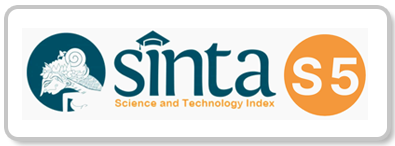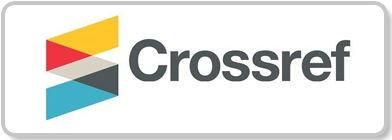Identifikasi Parameter Modal Model Bangunan Dua Lantai Menggunakan Metode Covariance-driven Stochastic Subspace Identification
DOI:
 https://doi.org/10.37859/jst.v12i1.9310
https://doi.org/10.37859/jst.v12i1.9310
Abstract
The modal parameters identification is a crucial part for designing and monitoring of a structure. This research is aimed to identify natural frequency and damping ratio of a lab-scaled two-story building model as a structure-under-test (SUT). The identification applies an operational modal analysis (OMA) technique, leveraging an algorithm of covariance-driven stochastic subspace identification (SSI-Cov) within PyOMA2 libraries. The SUT is subjected to random excitations using pseudo random signals within 0.1-25 Hz frequency range. The acceleration responses were sampled at 7.5 ms rate for 1 minute at each floor. Consequently, two modes with frequencies 2.2384 Hz and 5.9220 Hz are successfully identified below 25 Hz. These two modes yield 0.0135 and 0.0069 of damping ratios, respectively. These findings are compared to those of other algorithms that demonstrated a satisfactory identification of natural frequencies. However, a significant difference emerges in the identified damping ratios, particularly with regard to the second mode.
Downloads
References
Liu D, Tang Z, Bao Y, Li H. Machine-learning-based methods for output-only structural modal identification. Struct Control Heal Monit 2021;28:e2843. https://doi.org/https://doi.org/10.1002/stc.2843.
Xu Y, Zheng D, Shao C, Zheng S, Gu H. Structural Modal Parameter Identification Method Based on the Delayed Transfer Rate Function under Periodic Excitations. Mathematics 2023;11. https://doi.org/10.3390/math11041019.
Tavares A, Di Lorenzo E, Cornelis B, Manzato S, Peeters B, Desmet W, et al. Automated experimental modal analysis with density-based clustering: A benchmark validation through jury testing. Mech Syst Signal Process 2025;232:112714. https://doi.org/10.1016/j.ymssp.2025.112714.
Ebrahimi-Tirtashi A, Ahmadi K. Automated Operational Modal Analysis of self-excited vibrations in turning. Mech Syst Signal Process 2025;233:112705. https://doi.org/10.1016/j.ymssp.2025.112705.
Volkmar R, Soal K, Govers Y, Böswald M. Experimental and operational modal analysis: Automated system identification for safety-critical applications. Mech Syst Signal Process 2022;183:1–19. https://doi.org/10.1016/j.ymssp.2022.109658.
Orlowitz E, Brandt A. Comparison of experimental and operational modal analysis on a laboratory test plate. Meas J Int Meas Confed 2017;102:121–30. https://doi.org/10.1016/j.measurement.2017.02.001.
Galván J, Domínguez JM, Albizuri J. Operational modal analysis applied to floating offshore wind turbine dynamics identification in wave basins in the presence of free-surface modes. Ocean Eng 2025;327. https://doi.org/10.1016/j.oceaneng.2025.120909.
Dreher N, Machado T, Paulsen T, Santos I. Toward online stability margin tracking of Turbomachines via operational modal analysis. J Sound Vib 2025;610:119094. https://doi.org/10.1016/j.jsv.2025.119094.
Pais T, Silvestri P. Full scale cruise ship dynamic identification using operational modal analysis on sea trial data measurements. Ocean Eng 2024;311. https://doi.org/10.1016/j.oceaneng.2024.118931.
Pan H, Jiang F, Wu J, Deng T, Fu J. Bayesian operational modal analysis of two supertall buildings under Super Typhoon Saola. Eng Struct 2025;330:119907. https://doi.org/10.1016/j.engstruct.2025.119907.
Li S, Wang JT, Jin AY, Luo GH. Parametric analysis of SSI algorithm in modal identification of high arch dams. Soil Dyn Earthq Eng 2020;129:105929. https://doi.org/10.1016/j.soildyn.2019.105929.
Desjardins SL, Lau DT. Enhanced operational modal analysis and change point detection for vibration-based structural health monitoring of bridges. J Infrastruct Intell Resil 2024;3:100121. https://doi.org/10.1016/j.iintel.2024.100121.
Zini G, Betti M, Bartoli G, Chiostrini S. Frequency vs time domain identification of heritage structures. Procedia Struct Integr 2018;11:460–9. https://doi.org/10.1016/j.prostr.2018.11.115.
Peeters B, De Roeck G. Reference-based stochastic subspace identification for output-only modal analysis. Mech Syst Signal Process 1999;13:855–78. https://doi.org/10.1006/mssp.1999.1249.
Bono FM, Argentino A, Bernardini L, Benedetti L, Cazzulani G, Somaschini C, et al. Automated Operational Modal Analysis of a steel truss railway bridge employing free decay response. J Infrastruct Intell Resil 2025;4:100145. https://doi.org/10.1016/j.iintel.2025.100145.
Xu M, Au FTK, Wang S, Tian H. Operational modal analysis under harmonic excitation using Ramanujan subspace projection and stochastic subspace identification. J Sound Vib 2023;545:117436. https://doi.org/10.1016/j.jsv.2022.117436.
Adriyan, Bur M, Son L, Rusli M. Penerapan Analisis Modal Analitik dan Eksperimental untuk Identifikasi Parameter Modal Model Bangunan Dua Lantai. Semin. Nas. Tah. Tek. Mesin XI, Yogyakarta: 2012, p. 2188–94.
Bur M, Rusli M, Adriyan, Son L. Kaji Eksperimental Penerapan Metode Ibrahim Time Domain Untuk Identifikasi Model Bangunan Dua Lantai Dengan Gangguan Pada Tumpuan. Semin. Nas. Tah. Tek. Mesin XIII, Depok: 2014, p. 34–43.
Cao J, Yang Z, Lu M, Chen X. Compressive stochastic subspace identification: A modal parameter identification method suitable for compressive sampling. Mech Syst Signal Process 2025;223:111847. https://doi.org/10.1016/j.ymssp.2024.111847.
Salhi B, Lardiès J, Berthillier M, Voinis P, Bodel C. Modal parameter identification of mistuned bladed disks using tip timing data. J Sound Vib 2008;314:885–906. https://doi.org/10.1016/j.jsv.2008.01.050.
Pasca DP, Margoni DF, Rosso MM, Aloisio A. PyOMA2: An Open-Source Python Software for Operational Modal Analysis. In: Rainieri C, Gentile C, López MA, editors. Proc. 10th Int. Oper. Modal Anal. Conf. (IOMAC 2024). Lect. Notes Civ. Eng. vol 514., Cham: Springer; 2024, p. 423–434. https://doi.org/https://doi.org/10.1007/978-3-031-61421-7_42.
Pasquale D, Aloisio A, Martino M, Sotiropoulos S. PyOMA and PyOMA_GUI: A Python module and software for Operational Modal Analysis. SoftwareX 2022;20:101216. https://doi.org/10.1016/j.softx.2022.101216.
Granger BE, Pérez F. Jupyter: Thinking and Storytelling With Code and Data. Comput Sci Eng 2021;23:7–14. https://doi.org/10.1109/MCSE.2021.3059263.
Döhler M, Jaishi B, Mevel L, Brownjohn JMWW, Michael D, Jaishi B, et al. Data fusion for system identification of the humber bridge. Conf Proc Soc Exp Mech Ser 2011;4:83–98. https://doi.org/10.1007/978-1-4419-9316-8_7.
Dreher NR, Storti GC, Machado TH. Automated Operational Modal Analysis for Rotating Machinery Based on Clustering Techniques. Sensors 2023;23. https://doi.org/10.3390/s23031665.
Martino M, Aloisio A, Parol J, Carlo G, Quaranta G. Intelligent automatic operational modal analysis. Mech Syst Signal Process 2023;201:110669. https://doi.org/10.1016/j.ymssp.2023.110669.





















